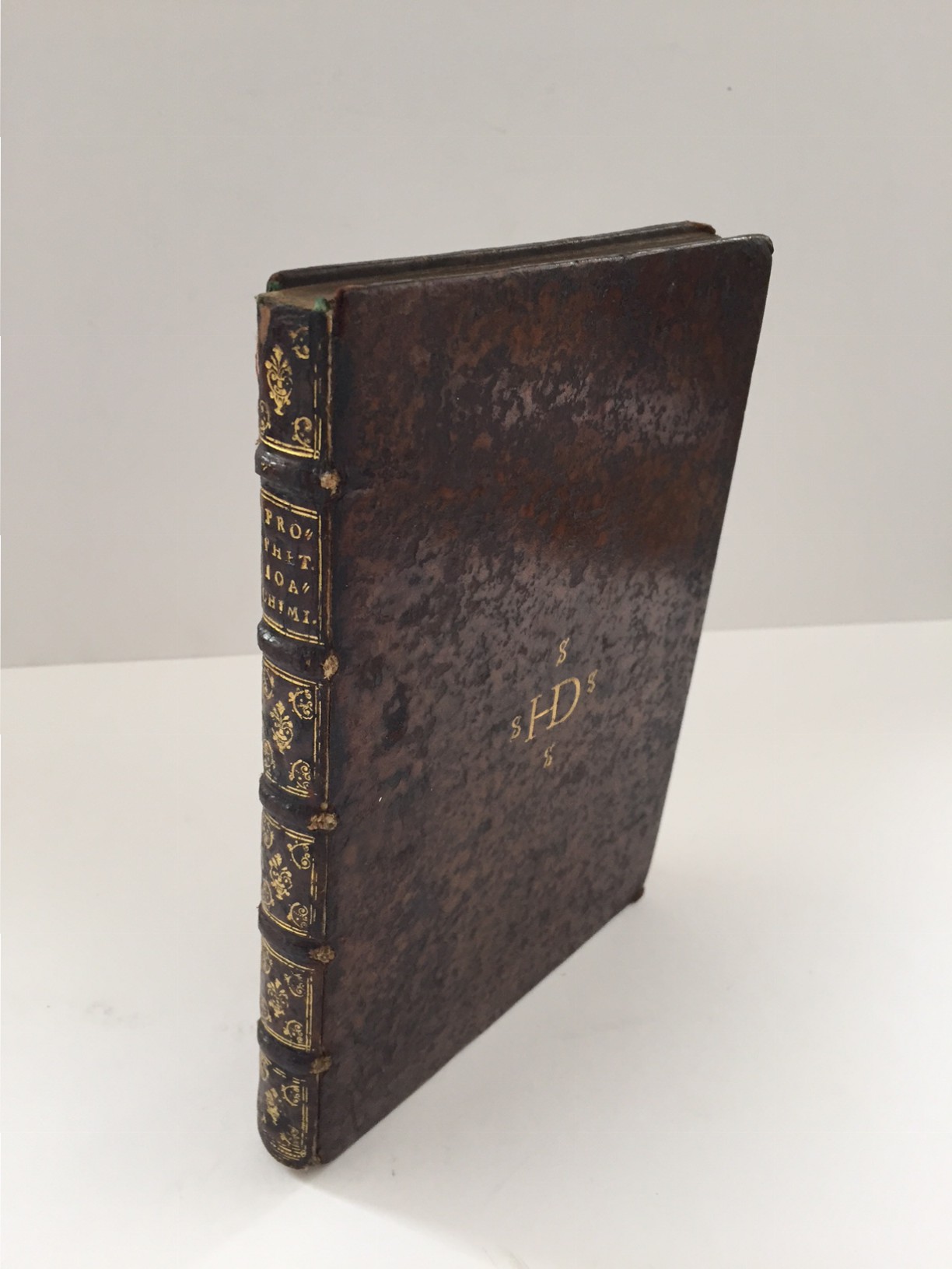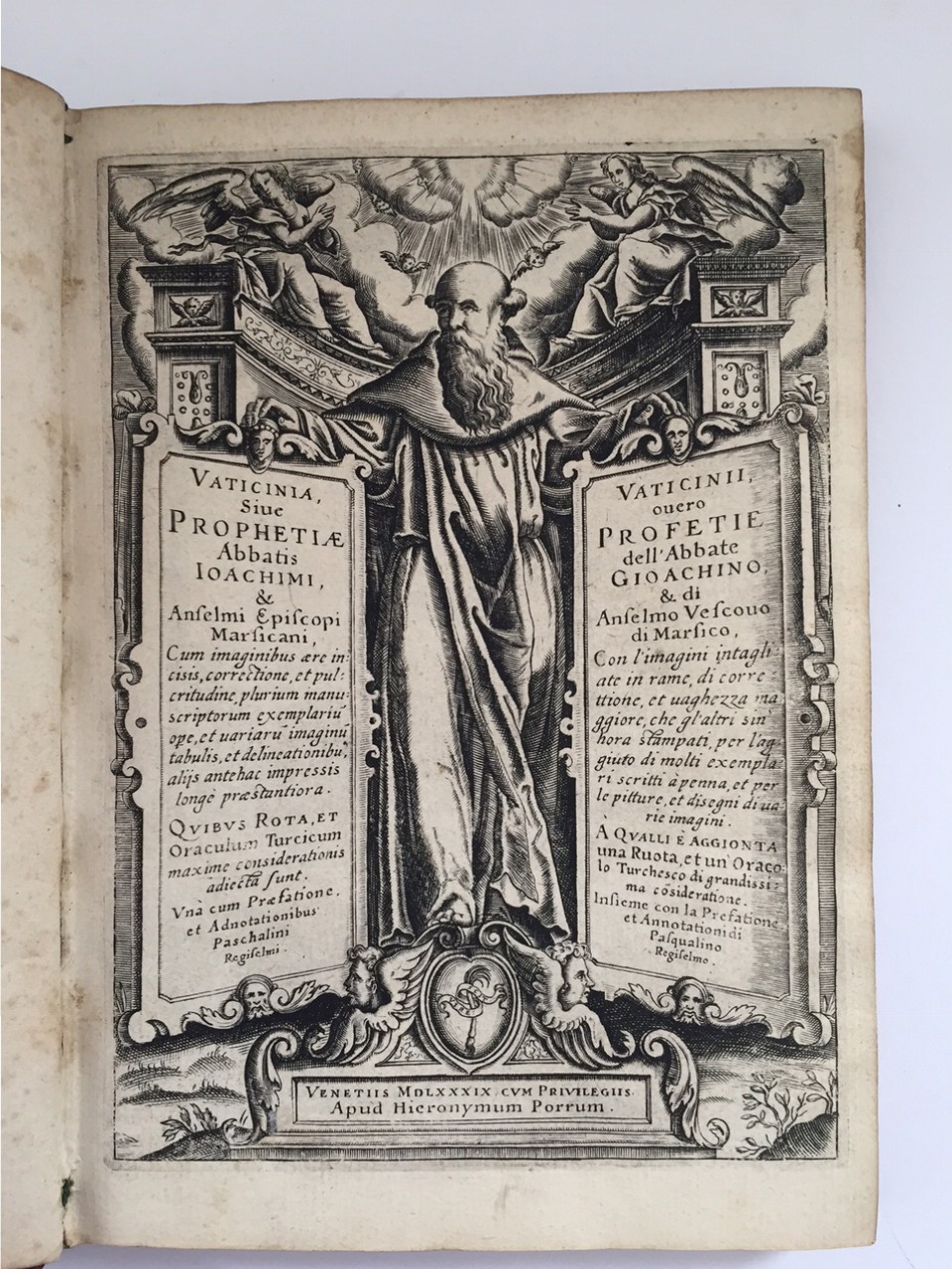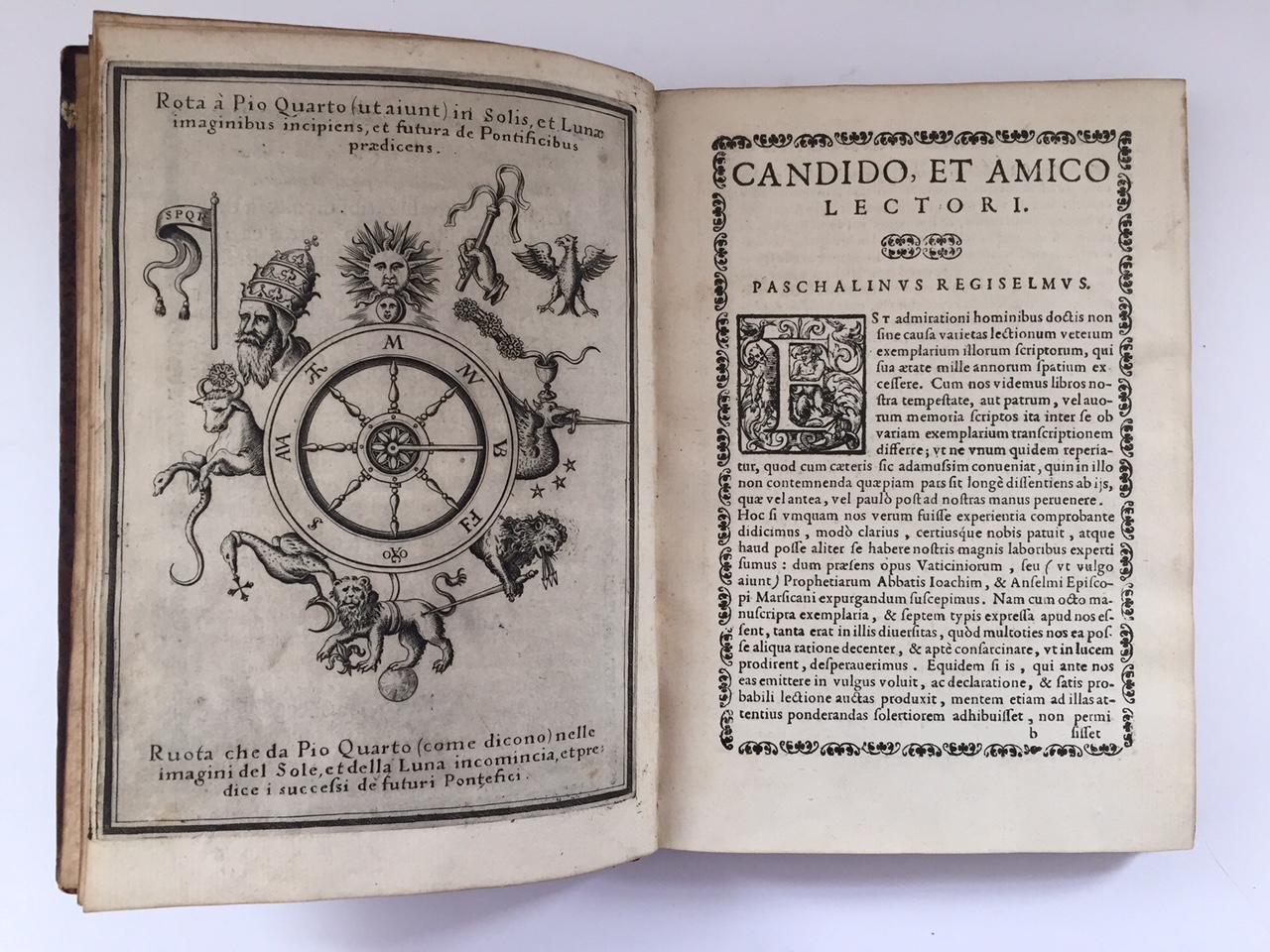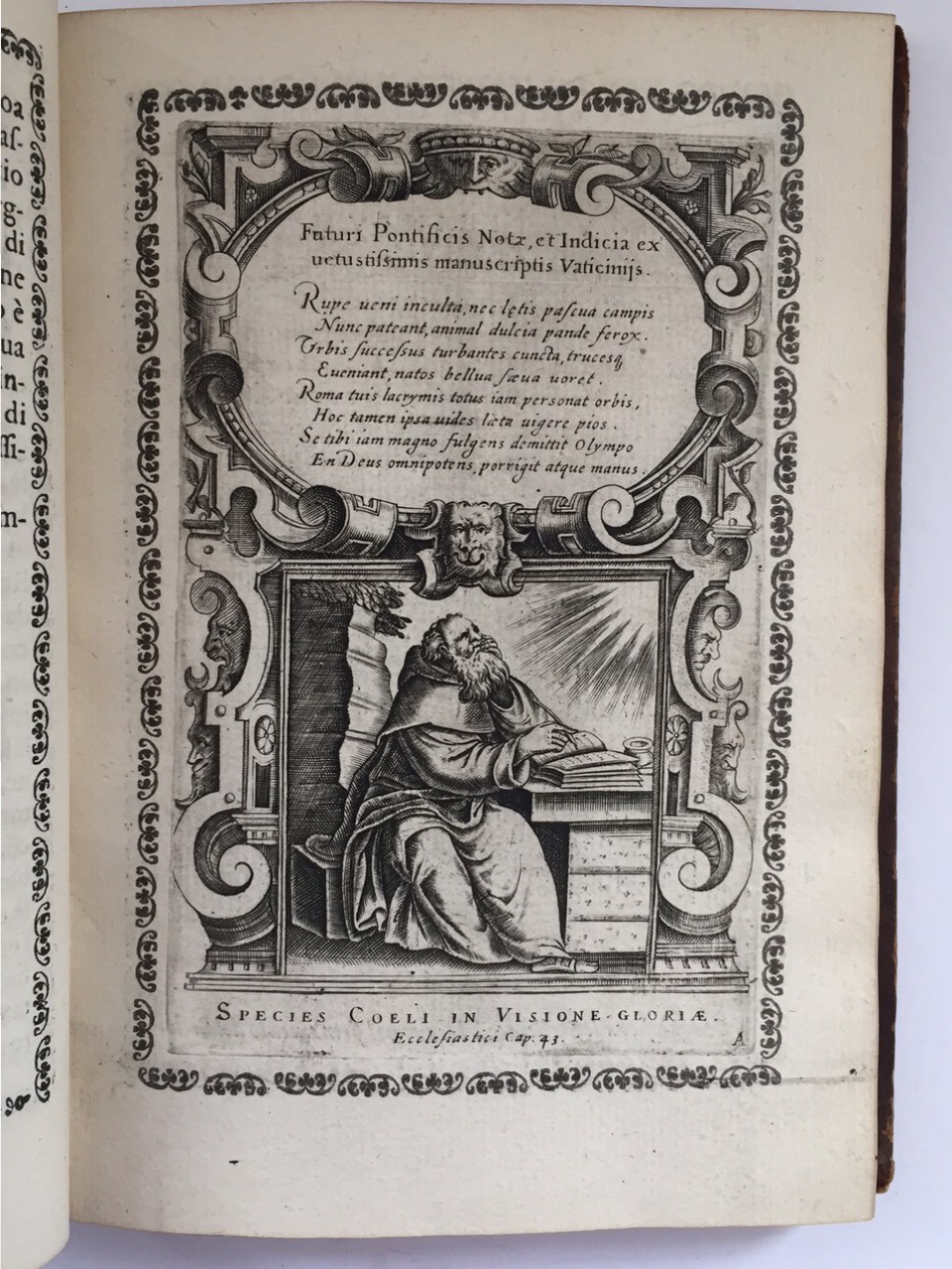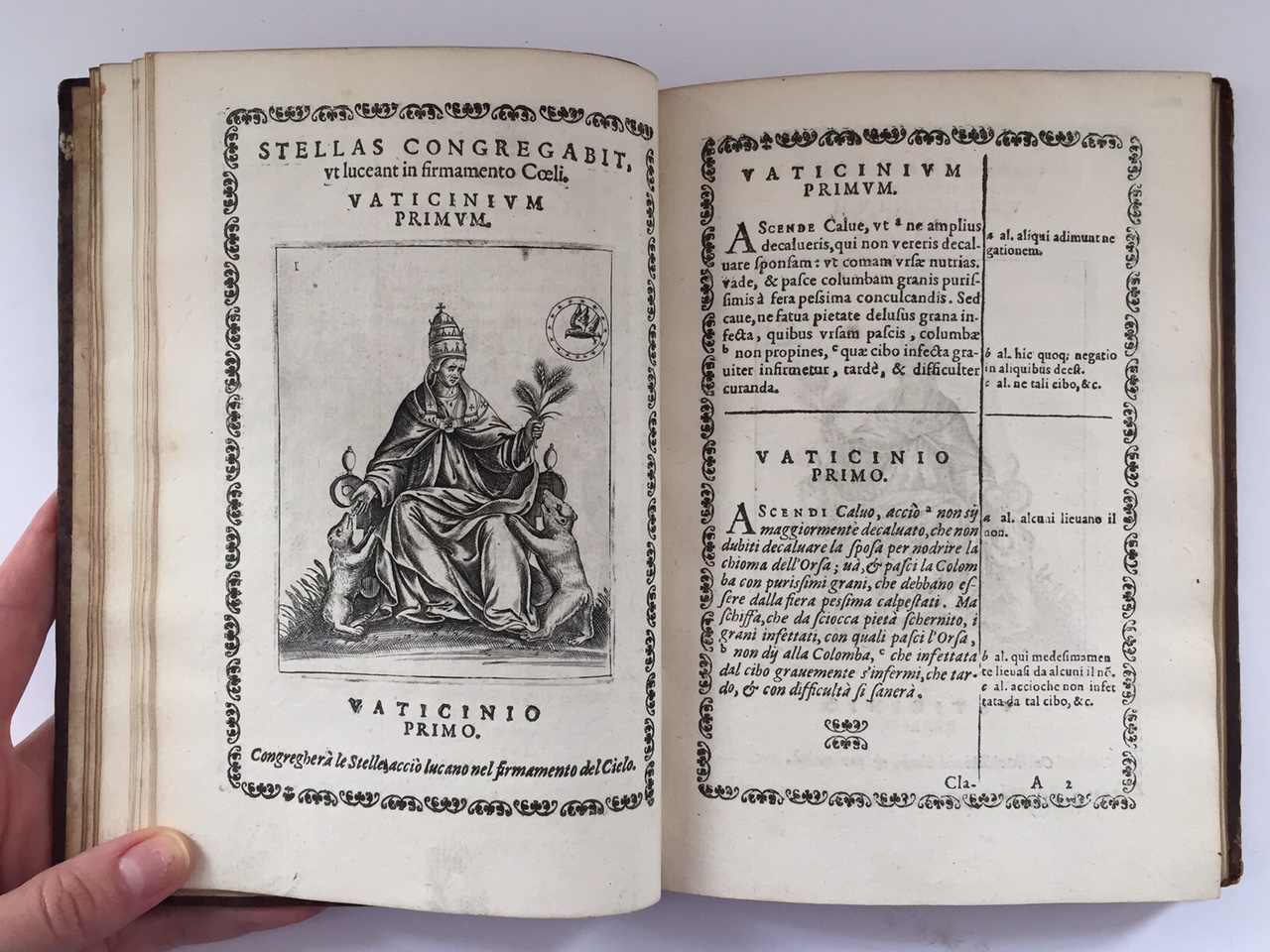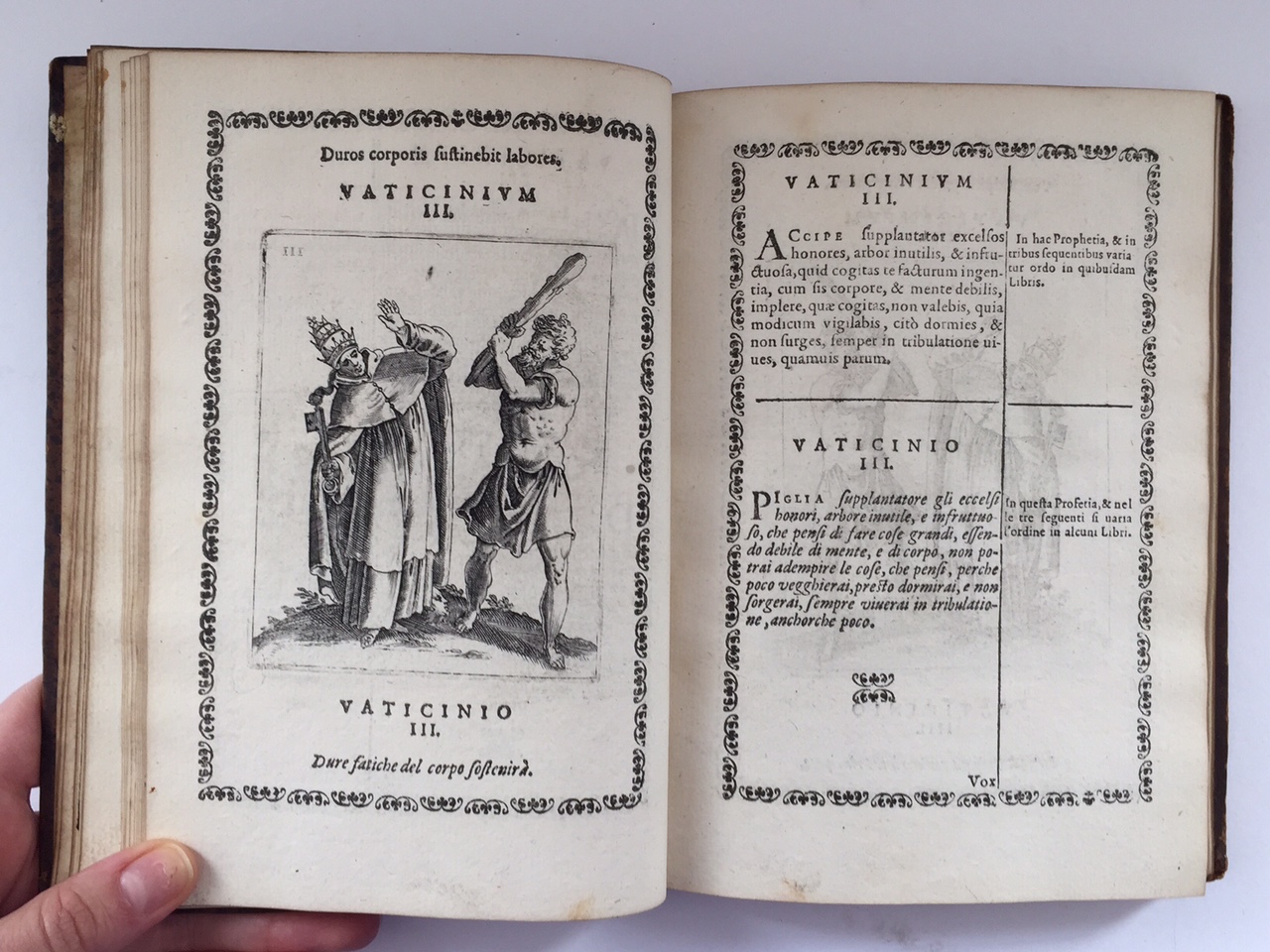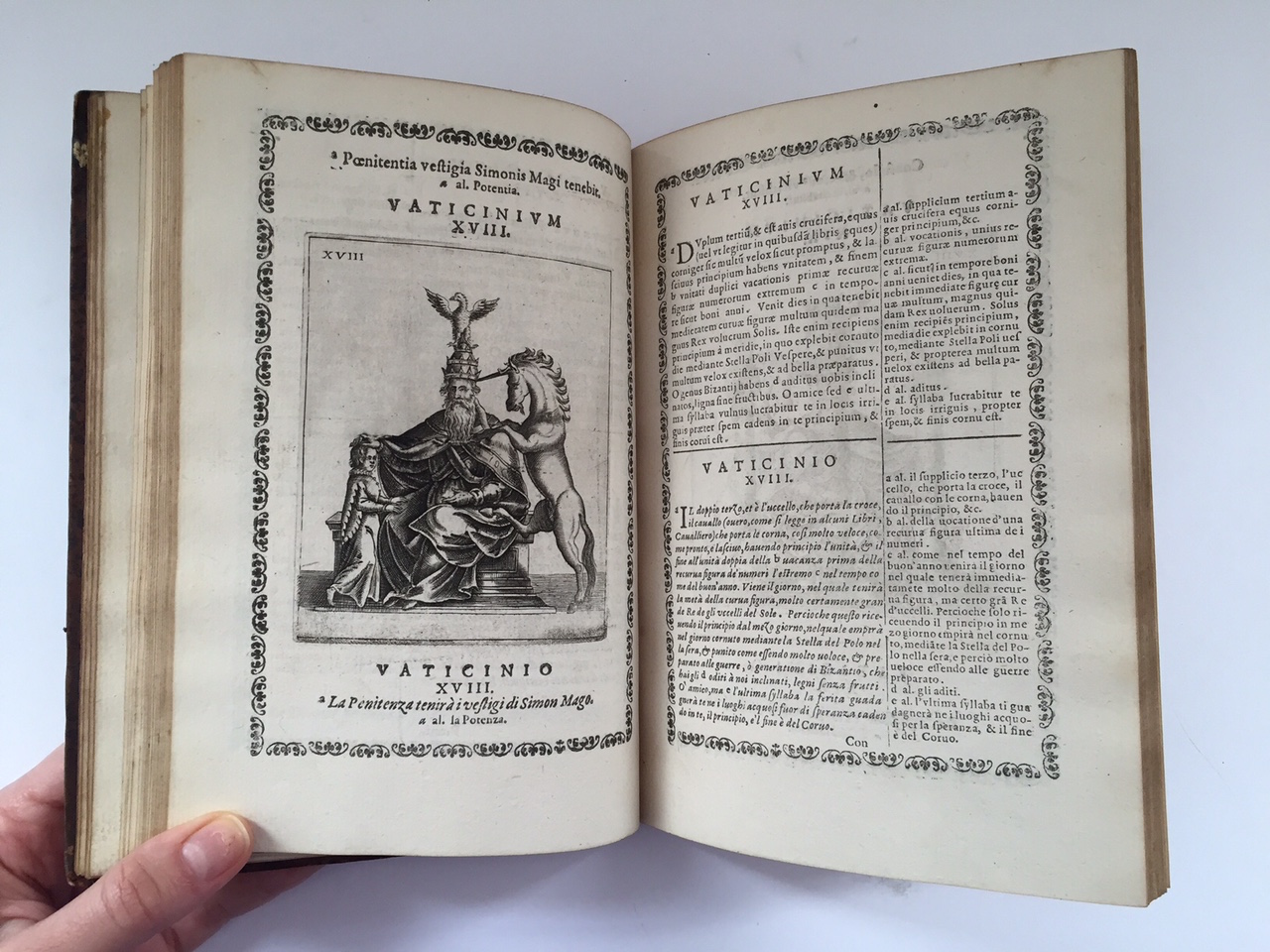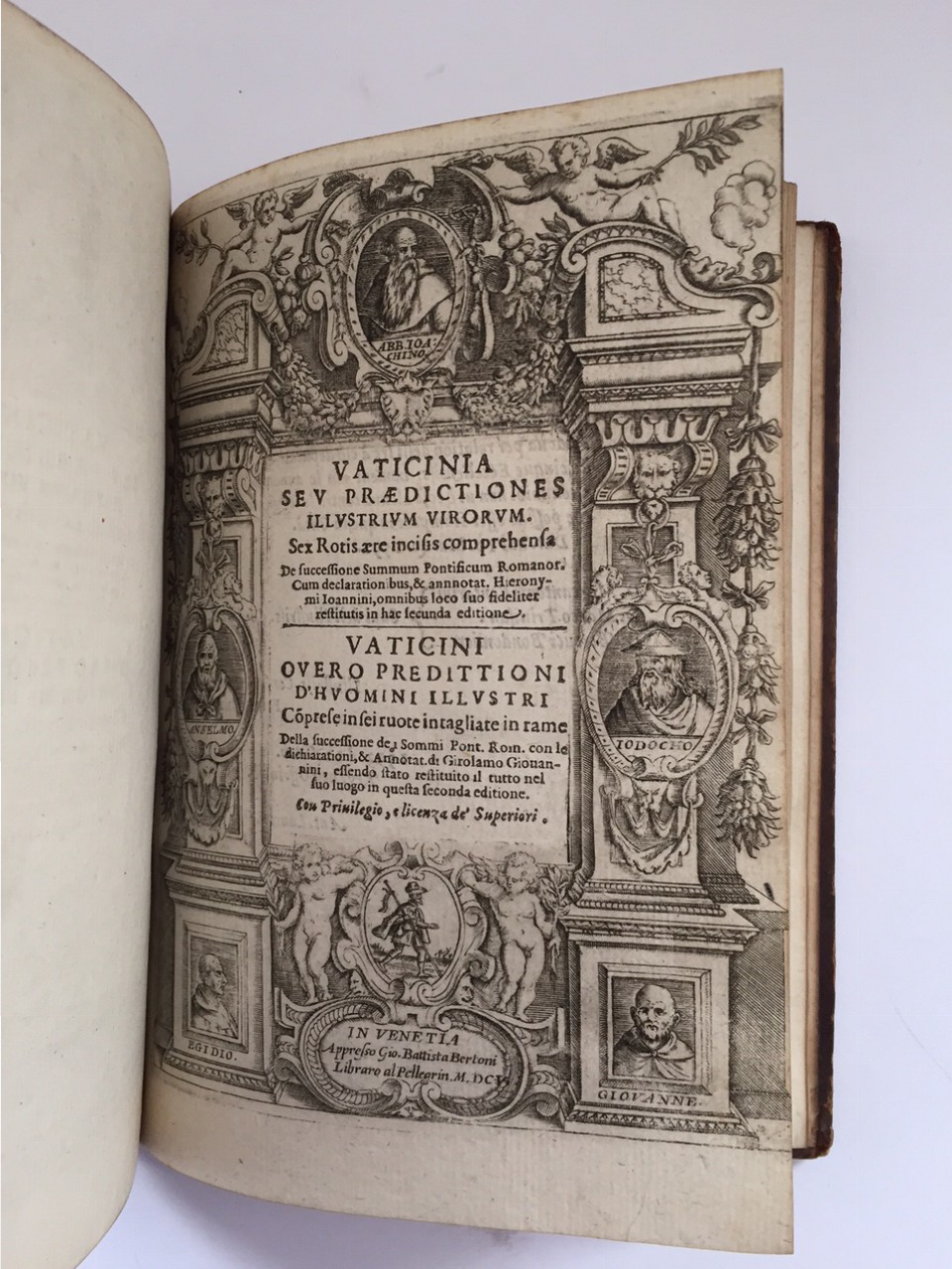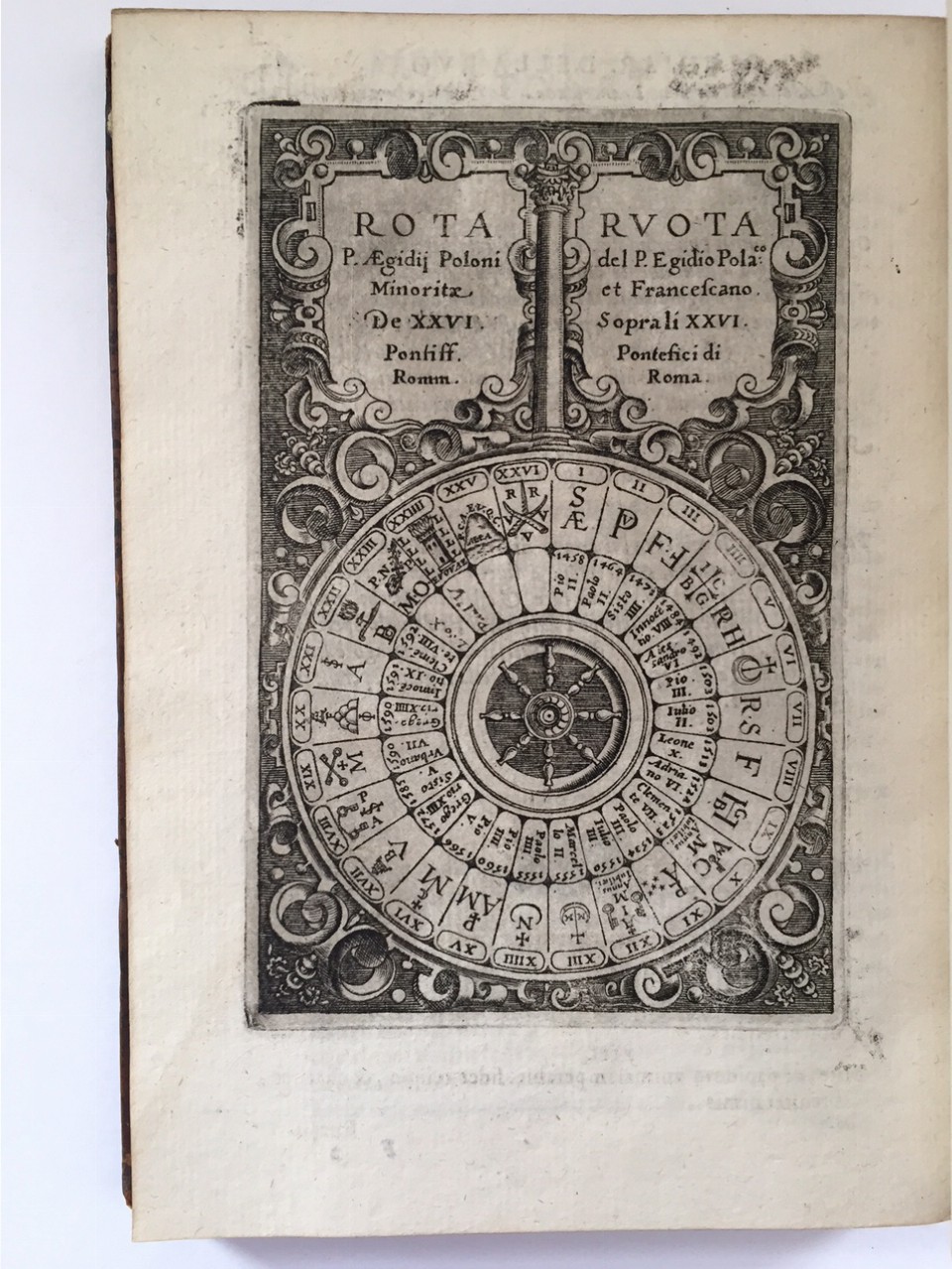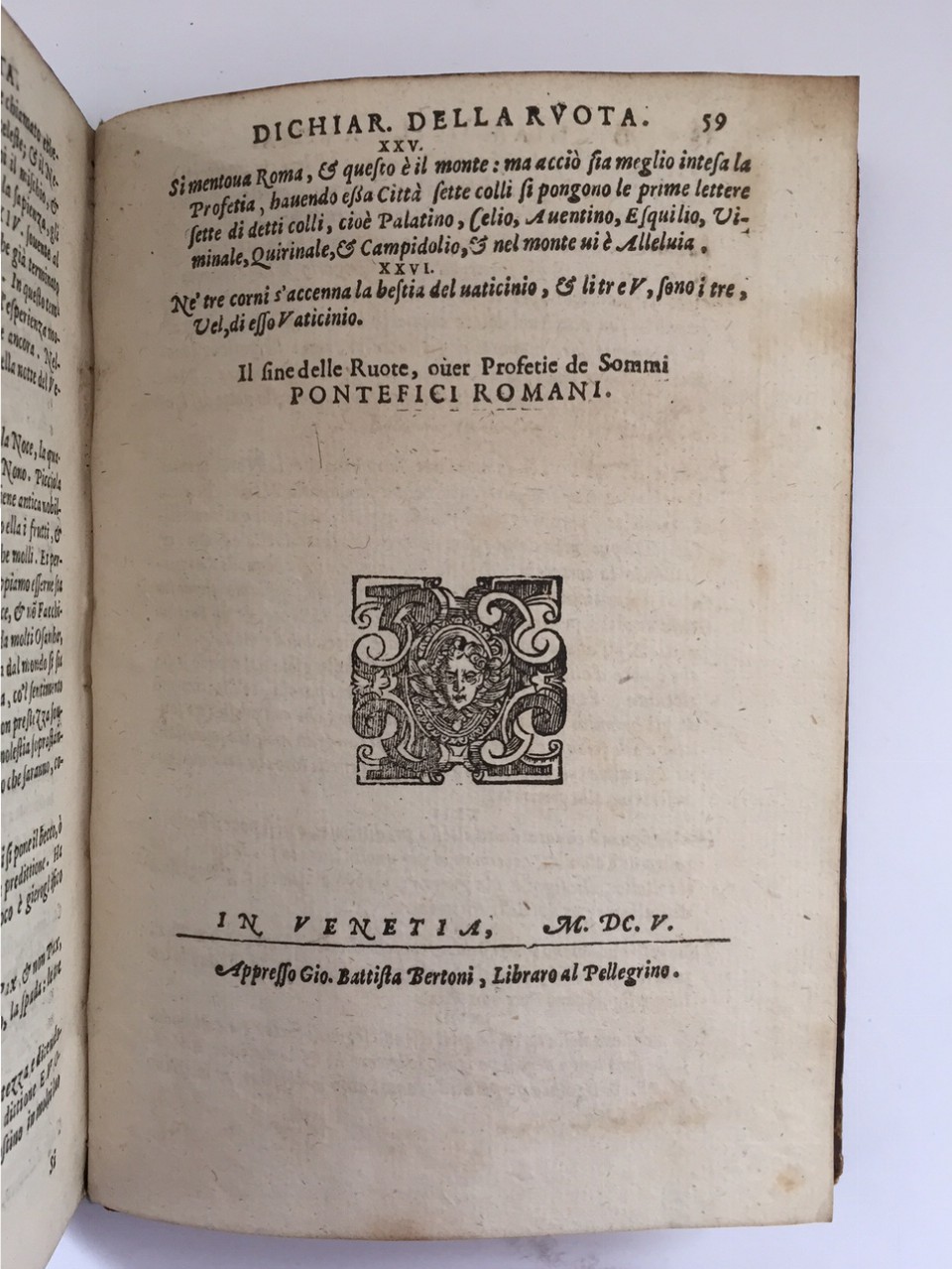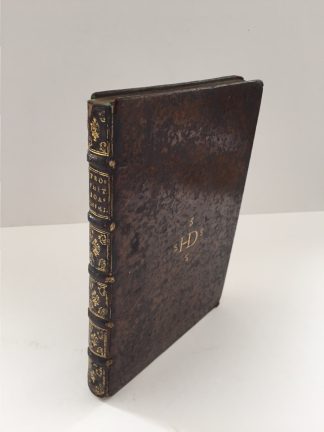JOACHIM, De Fiore
Vaticinia, siue Prophetiae abbatis Ioachimi, & Anselmi episcopi Marsicani, cum imaginibus aere incisis, correctione (with) Vaticinia seu praedictioner illustrium virorum ... Vaticini
Venice (and) Venice, apud Hieronymum Porrum (and) Giovanni Battista Bertoni, 1589 and 1605£4,750.00
FIRST EDITION thus. Two works in one. 4to. 1) 72 unnumbered leaves (with additional C4), a-d4, A-O4, (O3,4 blank). 2) pp. 59, [i]. A-F G . Roman and Italian letter. Engraved title with portrait of Joachim de Fiore, supporting two stone tablets, the title in Latin and Italian, four full page and 30 half page engraved plates by Girolamo Porro of portraits of Popes with Latin captions and Italian translations, extra illustrated with another variant of the portrait of Joachim on C4 tipped in, this one full page, plate of ‘Oraculum Turcicum’ with caption in Turkish characters and engraved text below, text within typographical border, large woodcut initials and grotesque headpieces; title of second work within fine engraved architectural border, six full page engraved plates by Porro. ‘Liber Georgius W. Dasent. Ex Aul S. Magdalena oxon. 103 ch’ in C19th hand on fly, early ms shelf mark opposite, engraved bookplate of S.A. Thompson Yates on pastedown, bibliographical pencil note below concerning the binding. Light age yellowing, occasional marginal thumb mark or spot, second title fractionally trimmed at outer margin. Very good copies, crisp and clean, with good margins, the engravings in rich, dark, impressions, in contemporary speckled calf, spine with raised bands, double gilt ruled in compartments with scrolled tools to corners and central fleurons gilt, monogram HD gilt on covers, surrounded with four crossed S tools, a.e.g., joints and corners a little worn, modern brown morocco slipcase.
First edition, beautifully illustrated with the fine engraving of Giralamo Porro, of the medieval Papal prophecies, wrongly attributed to Joachim of Fiore, including a final prophecy predicting the fall of the Turkish Empire, the so called ‘Red Apple’ prophecy. The work contains the commentary on the prophecies by Pasqualino Regiselmo. There were three variants of this first edition according to Edit 16, all line by line copies, and this copy has been extra illustrated with the variant, fine, full page engraved portrait of Joachim writing by divine inspiration; it also has the full page image of the ‘Wheel of the Popes’. There follow the 30 prophecies in Latin and Italian, each illustrated by fine emblematic engravings, the Turkish prophecy, with a full page illustration, and Regiselmo’s commentary. A series of prophecies concerning the Papacy circulated in ms. from the late thirteenth to early fourteenth century concerning popes from Pope Nicholas III onwards, in the form of a Latin text which assembled portraits of popes and the prophecies related to them. The texts and illustrations are so closely related they must have been conceived together. The prophecies, based on Greek prototypes, were probably intended to influence one of the ongoing papal elections, possibly written in opposition to the Orsini and their candidates. They are derived from the Byzantine Leo Oracles, a series of twelfth-century Byzantine prophecies that foretell a savior-emperor destined to restore unity to the empire.
The series was augmented in the fourteenth century with further prophecies, written in imitation of the earlier, but with more overtly propagandist aims. By the time of the Council of Constance (1414–1418), both series were united as the ‘Vaticinia de summis pontificibus’ and misattributed to the Calabrian mystic Joachim de Fiore. Each prophecy consists of four elements, an enigmatic allegorical text, an emblematic picture, a motto, and an attribution to a pope. The final prophecy tells the vision of Mehemet II in which he holds a red apple which becomes progressively heavier and heavier so as to be unbearable. It prophesies the capture of Constantinople from the Christians and its later recapture and destruction of the Turks. A very good copy of this finely illustrated work.The second book contains prophetic writings falsely ascribed to Joachim, Anselmus, and other medieval mystics, illustrated with six complex prophetic astrological wheels related to various Popes. This works had previously been published with woodcut illustrations; Girolamo Porro was the first artist to supply these superb copper-engraved plates.
Sir George Webbe Dasent (1817–1896) was a translator of folk tales, a friend of Jacob Grimm, at whose recommendation he first became interested in Scandinavian literature and mythology. In 1842 he published the first result of his studies, an English translation of ‘The Prose or Younger Edda’. In the following year he translated Rask’s ‘Grammar of the Icelandic or Old-Norse Tongue’, taken from the Danish, and later ‘The Story of Burnt Njal’, a translation of the Icelandic ‘Njal’s Saga’ and ‘East O’ the Sun and West O’ the Moon’, a collection of Norwegian fairy stories. The book then passed into the extraordinary collection of the famous bibliophile Thompson-Yates.
The binding is of great interest. Guigard (Vol I p. 20-22) attributes the monogram HD with the surrounding four’S’ tools to Henry IV of France and his lover, and the mother of his Children, the famous courtesan Gabrielle D’Estrées.. He suggests that as this monogram also appears on a work with Louis XIII’s and Ann of Austria’s crowned monograms, the work could have passed from Gabrielle’s library to Louis’. The S with a line through it is thought to be a punning cipher, devised by Henry IV, for Gabrielle d’Estrées; the surname being represented by a capital S. with ‘un trait’, or stroke through it (S-trait – Estrées.). Hobson devoted an entire article on the ‘S’ appearing on book bindings from ca. 1580 till 1640 and surrounding a monogram. (G.D. Hobson, ‘Le problème de l’S fermé’: Hobson, ‘Les reliures à la fanfare’, pp. 85-119, Amsterdam 1970) He rejects Guigard’s suggestion that the monogram could be that of King Henry IV, and Gabrielle d’Estrées. Hobson considers various possibilities regarding the meaning of the ‘closed S’, suggesting it could be an emblem of fidelity or an emblem of the loyalty to the Bourbon family; it could also mean ‘Sigillum’. Guigard also states that the ’S’could stand for “fermesse pour fermement. Cette interpretation est confirmée par le Seigneur des Accords” but also notes that the monogram appears on other bindings that don’t have a sentimental attachment to them. A most intriguing binding and a lovely copy of these works, with excellent provenance.
BM STC It. C16th p.356. Adams J213. Landwehr, Romantic emblem books 415. Caillet 5541 “fort rare .. fort interessantes”. Dorbon-Ainé 2279: \"Édition très rare, surtout intéressante pour son illustration.. tout fort curieuses”.In stock


